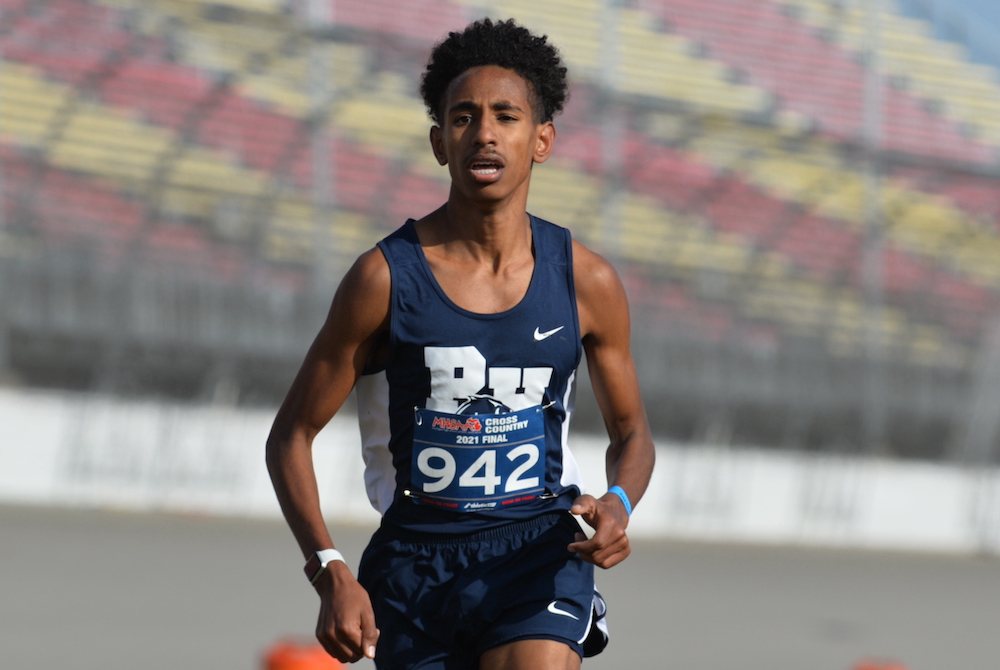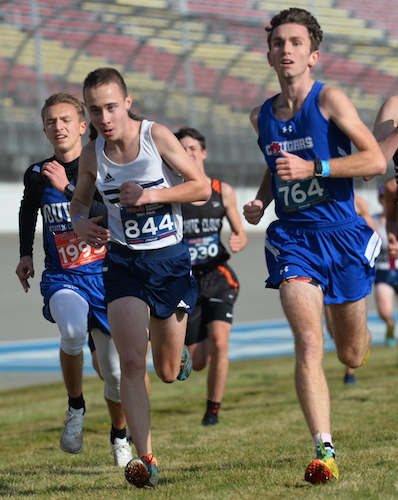
Potter's House's Osterink, Hillsdale Academy Earn 1st Finals Wins
November 6, 2021
BROOKLYN — Lezawe Osterink’s arrival among the state’s elite was deferred for a year.
He was ready to make a run at the MHSAA Lower Peninsula Division 4 cross country championship in 2020, but was unable to run at Regionals after breaking his collarbone on a training run.
Who says cross country isn’t a contact sport?
The junior from Wyoming Potter’s House showed up Saturday at Michigan International Speedway as a different runner than the one who had a respectable 55th place as a freshman in 2019.
Osterink completed an undefeated season by winning the Division 4 race in 15:50.60. He won by 23.76 seconds ahead of Concord senior Jonathan Mikovits.
Last year, Osterink was on track to get to MIS when he won the Pre-Regional meet.
“I broke my collarbone before Regionals, then I got COVID,” he said. “That was kind of a big disappointment. I couldn’t run at all. We were going to try to push it and try to win state that year.”
 Osterink won all 13 races in which he competed this fall, giving him a 14-race winning streak going back to last season.
Osterink won all 13 races in which he competed this fall, giving him a 14-race winning streak going back to last season.
After racing at MIS as a freshman, he began to dream about becoming a Finals champion.
“I didn’t know if it would become realistic,” Osterink said. “I put in a lot of work. Our coach knows what he’s doing. I had good teammates to train with. That’s what I would say got me here.”
Osterink reached the mile mark in 5:03.3, giving him a 4.6-second cushion over Mikovits. The lead increased to 7.6 seconds when Osterink hit a two-mile split of 10:10.1.
“I could feel myself running away,” he said. “I was surprised. They went out good. They stuck with me for a while. I was scared of the guy behind me. I didn’t look back, but people who were there said he was close, so I had to keep hammering the whole time.”
In the team competition, Hillsdale Academy grouped its second through fifth runners only 13 seconds apart to win with a score of 154 points.
Senior Emil Schlueter gave Hillsdale Academy a low stick with his eighth-place finish in 16:49.75, good for sixth among team runners. Two eighth-graders scored for the Colts: Cole Bates (64th, 17:56.70) and Grayson Rorick (72nd, 18:02.22). Also scoring were sophomore Thomas Holm (51st, 17:49.17) and freshman Vincent Reagle (69th, 17:59.71).
It was the first MHSAA team championship for the Colts, whose best finishes were 10th-place showings in 2010 and 2018.
Concord had three runners in the top 22, but had to count runners who were 75th and 159th overall.
PHOTOS Potter’s House’s Lezawe Osterink approaches the finish of the Division 4 Final at Michigan International Speedway. (Middle) Hillsdale Academy’s Thomas Holm (844) and Adrian Lenawee Christian’s Grant Long (764) push down the final stretch. (Click for more from RunMichigan.com.)

MHSAA Vault: MIS Rose to Challenges to Host 2020 LP Finals
By
Rob Kaminski
MHSAA benchmarks editor
November 12, 2021
The “MHSAA Vault” features stories from past publications and other documents in the MHSAA Library. This issue takes a look at the MHSAA Cross Country Finals at Michigan International Speedway, which celebrated 25 years in 2020 – although it was an event that nearly didn’t happen last fall …
In 1996, the MHSAA and Michigan International Speedway began a partnership the changed the course of the Lower Peninsula Cross Country Finals – quite literally.
The land in and around the track at Brooklyn would host the Finals for all classes of runners in one place on one day, an annual festival of nearly 2,000 runners competing for the MHSAA’s top honors.
Even skeptics – and there were several among running purists who thought the course was too flat, for example – can’t deny the results.
Finals attendance nearly doubled in that first year, and crowds in excess of 10,000 have enjoyed a day of racing several times, including a record 12,153 in 2011.
Enthusiastic crowds were the norm in recent years, with 11,232 in 2017, and nearly 11,000 in 2018 (10,989) and 2019 (10,873).
In fact, attendance failed to reach at least 8,000 only twice since the move to MIS.
Of course, last year was an exception, when attendance was limited to 1,000 spectators per session due to the COVID-19 Pandemic. Fans also were restricted to the grandstands rather than following the action throughout locations on the course.
To reduce the number of runners in each race, the event was spread over two days, with each Division being run in two separate “sections” with times then combined at the end to determine team and individual champions.
While not ideal, the end result was another year of fantastic efforts at MIS – both from student-athletes and those behind the scenes.
“Even at the last hour, less than a week ahead of the Finals, we were closer to not having the Finals than we were to having them,” said MHSAA Assistant Director Cody Inglis, who coordinates the cross country postseason. “Rumors and challenges of mandated shutdowns, testing and other requirements were being discussed and caused a lot of unknowns. Even at the Regional level, we had schools, Regional courses and hosts shutting down their facilities; we had to relocate four Regionals 48 hours prior to race times. That scenario just could not happen at the Finals level where far more runners and much more travel would be involved.”
Among the many last-minute hurdles was the edict from NASCAR – which owns MIS – that all persons on site be temperature checked upon entry. That meant securing thermometers that were easy to operate in short order, along with personnel necessary to conduct the readings.
The attendance limitations certainly helped to implement the temperature screening, but brought their own issues.
“Limiting spectators was not a popular decision, but it really was the only way to have a race,” Inglis said. “We were taking direction and working with policies and protocols from the MDHHS, the Governor’s office, Lenawee County Health Department, MIS and NASCAR.”
Part of the solution was to utilize the grandstands as a “barrier” between participants and spectators. The reduced number of fans were dispersed over thousands of seats while still allowing them the chance to watch their student-athletes compete.
“It wasn’t the same, it wasn’t easy or perfect, but it was what we had to do to have a race,” Inglis said. “Separating the Finals into two days and different sections also allowed us to spread out the event and limit the number of people on site at any one time. This was a key part of the plan and worked well even though it separated races within a Division.”
The MHSAA, MIS and the cross country community never lost focus of the main goal: a culmination of the season for the student-athletes, who deserved something last year more than ever. And, more than ever, MIS once again displayed its advantage as a venue that could adapt to the fluid nature of the times to pull off the event.
“There were some thoughts of using four different sites, but as we learned during the Regionals, the climate of things was so tenuous from one area of the state to another that we couldn’t be 100-percent certain that there wouldn’t again be last-minute cancelations,” Inglis said. “MIS was wonderful to work and collaborate with, and was the best option to get it done. It was never mentioned once publicly about the possibility of not having the Finals – only how we could best do it under uncharted conditions.”
The moving parts and ever-changing scenarios created more complexity than ever in finalizing a season, but every decision was made with the complete desire to conduct the Finals as close to normal as possible.
“I firmly believe that a finish to the season, no matter the differences in race formatting and fan experience, was something everyone would have taken when the season began in August,” Inglis said.
Indeed, the finish line in Year 25 at MIS might have been the most gratifying of them all.

